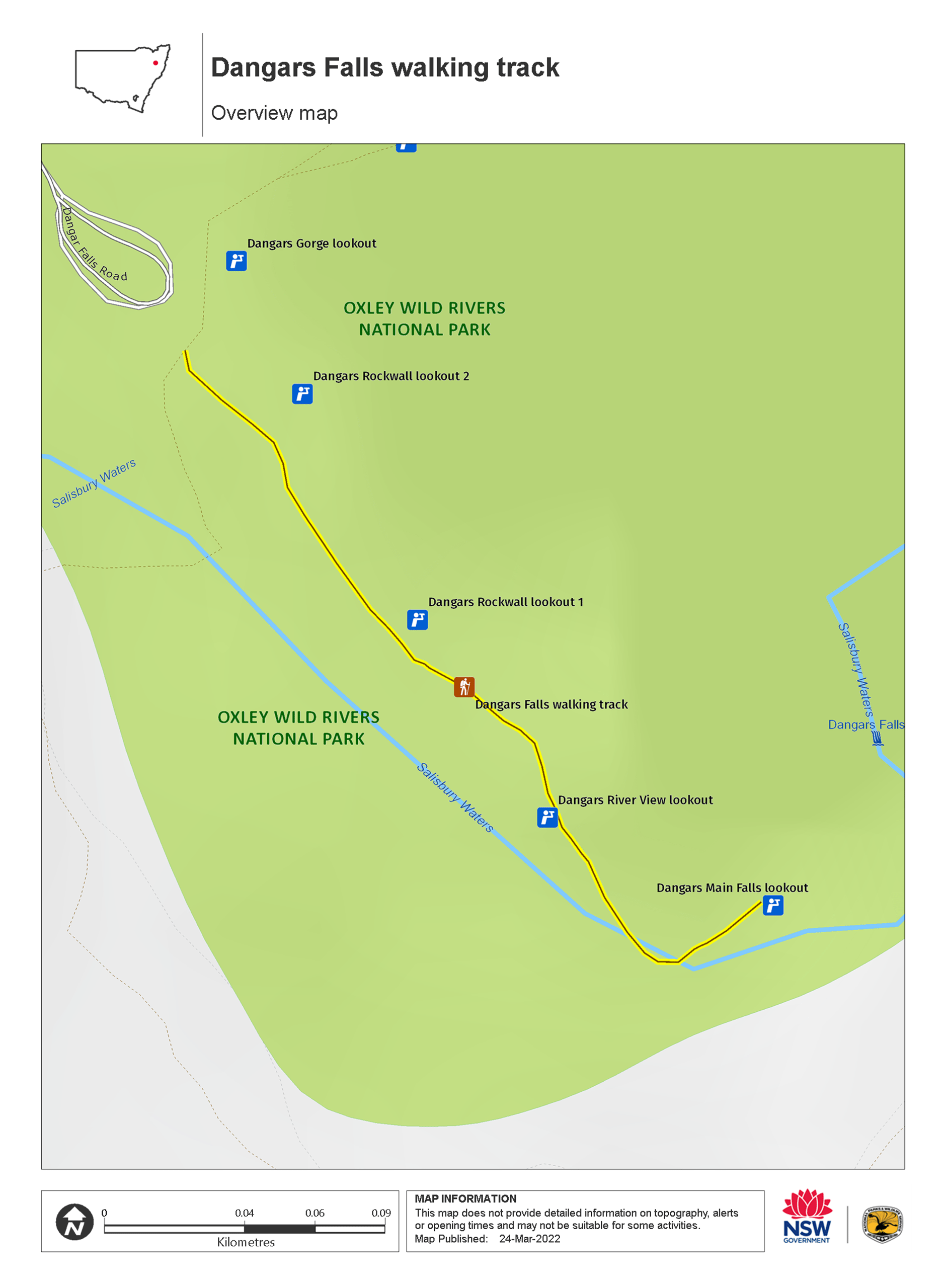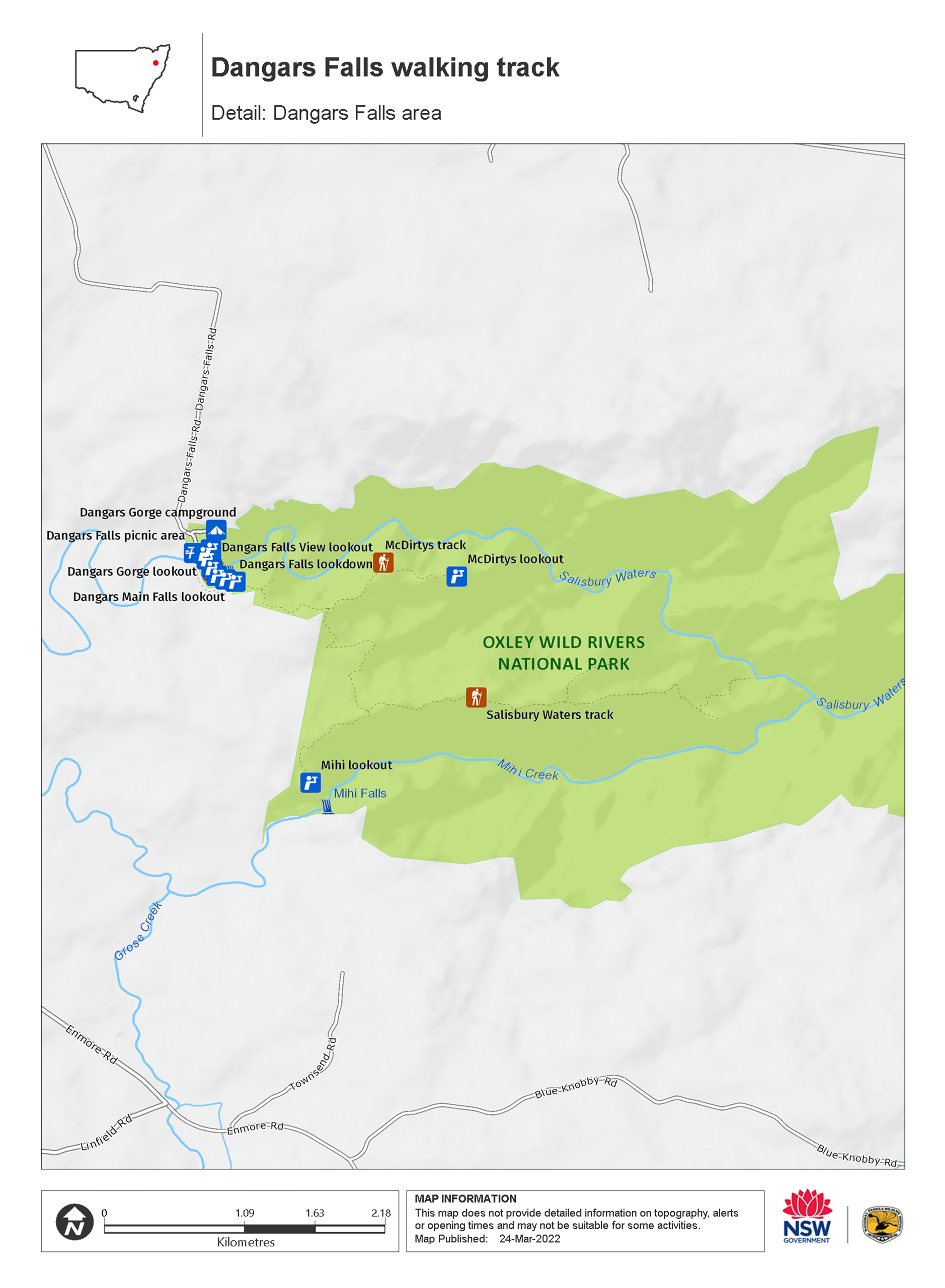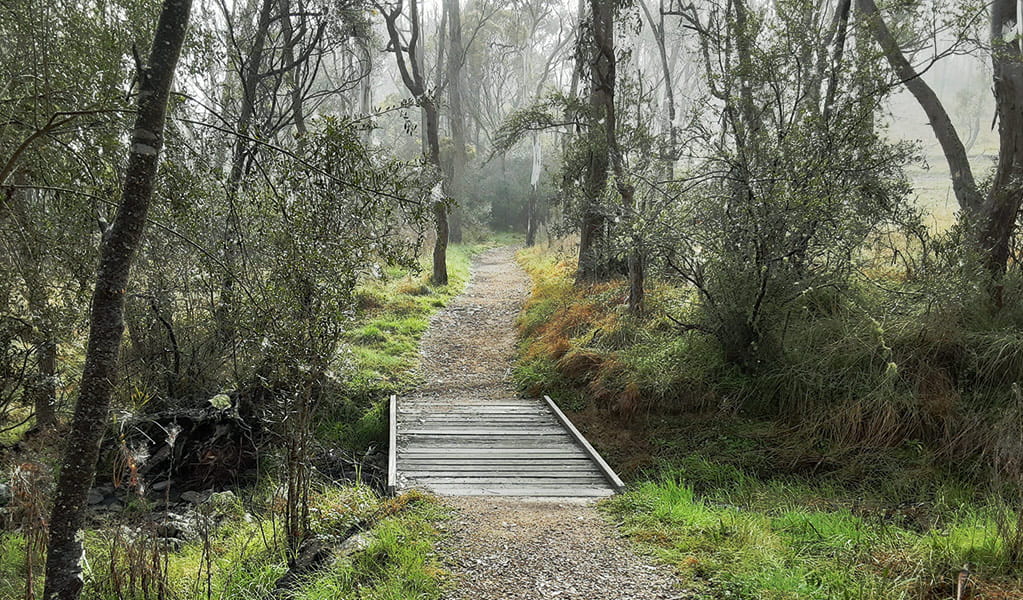Dangars Falls walking track
Oxley Wild Rivers National Park
Overview
Dangars Falls walking track is a great introduction to the waterfalls, rivers and gorges of Oxley Wild Rivers National Park, near Armidale. A short and easy stroll, it delivers you right into the heart of this vast World Heritage Area.
- Accessibility
- Hard
- Distance
- 0.6km return
- Time suggested
- 30min
- Grade
- Grade 2
- What to
bring - Suitable clothing, drinking water
Dotted with scenic lookouts, Dangars Falls walking track is short on distance but long on stunning waterfall vistas. Do this 600m return walk on a day trip as a short detour off Waterfall Way. Or combine it with other walks when staying at nearby Dangars Gorge campground.
Starting from Dangars Falls picnic area, the walk takes in spectacular lookouts over Dangars Falls and the gorges of Salisbury Waters. A series of steps delivers you to a viewing platform right over the cascades of Dangers Falls. Be sure to bring your camera to capture the beauty of the falls, especially after periods of rain when they’re at their most sublime.
Nature lovers will find much to enjoy here. Spectacular old growth Gondwana Rainforest flourishes in gorges, and a microclimate along the gorge rims creates an environment where threatened plants survive. Animal lovers will want to keep an eye out for endangered brush-tailed rock wallabies as well as the diverse suite of birds that call this place home.
If this taste of gorge country kindles your spirit of adventure, try the more challenging McDirtys and Salisbury Waters walking tracks, both nearby.
On the way
-

Dangars Rockwall lookout 1
Dangars Rockwall lookout 1 is in Oxley Wild Rivers National Park, along Dangars Falls walking track. It’s a great spot to see the great chasm below Dangars Falls.
-

Dangars Rockwall lookout 2
Dangars Rockwall lookout 2 is in Oxley Wild Rivers National Park along Dangars Falls walking track. It’s a great spot to view the steep cliff walls and chasm below Dangars Falls.
-

Dangars River View lookout
Dangars River View lookout is in Oxley Wild Rivers National Park, along Dangars Falls walking track. Rest here to enjoy views of Salisbury Waters, near Armidale.
-

Dangars Main Falls lookout
Dangars Main Falls lookout is in Oxley Wild Rivers National Park near Dangars Falls picnic area. It’s a great spot to view this stunning 120m waterfall, near Armidale.
Map

Map

Map legend

Local alerts
For the latest updates on fires, closures and other alerts in this area, see https://www.nationalparks.nsw.gov.au/things-to-do/walking-tracks/dangars-falls-walking-track/local-alerts
General enquiries
- National Parks Contact Centre
- 7am to 7pm daily
- 1300 072 757 (13000 PARKS) for the cost of a local call within Australia excluding mobiles
- parks.info@environment.nsw.gov.au
Park info
- in Oxley Wild Rivers National Park in the North Coast and Country NSW regions
Oxley Wild Rivers National Park is always open but may have to close at times due to poor weather or fire danger.
-
There are 3 areas in Oxley Wild Rivers National Park where you'll need day use vehicle permits: Halls Peak campground and picnic area, Riverside campground and picnic area, and Youdales Hut campground and picnic area. Day use vehicle permits can be bought online or by calling the National Parks Contact Centre on 1300 072 757. If camping, permit fees are included in the campground fee.
Contact us for permits.
Visitor info
All the practical information you need to know about Dangars Falls walking track.
Track grading
Features of this track
Distance
0.6km return
Time
30min
Quality of markings
Clearly sign posted
Experience required
No experience required
Gradient
Gentle hills: The walk has moderate slopes mixed with steeper flights of steps.
Quality of path
Well-formed track: The walk is 1.5m-wide with sections of sealed bitumen and sections that are elevated metal grille boardwalk.
Steps
Occasional steps: There are around 65 metal grille steps along the walk:
- Most of the steps are in sets of 4 or 5
- There are some longer flights of steps as you near the main falls lookout.
- There are no steps along the first 200m of the walk that takes you from Dangar Falls picnic area to River View lookout.
Accessible options
The first 200m of the walk from Dangars Falls picnic area to River View lookout is sealed bitumen and step-free. This part of the walk is accessible for people with reduced mobility.
Getting there and parking
Dangars Falls walking track is in the Dangars Gorge area of Oxley Wild Rivers National Park. To get there from Armidale:
- Drive on Dangarsleigh Road for about 8km.
- Turn left on Dangars Falls Road (unsealed road) and drive for almost 11km.
- Park at Dangars Falls picnic area, where the walking track starts.
Road quality
- Unsealed roads
Vehicle access
- 2WD vehicles
Weather restrictions
- All weather
Parking
Parking is available in bitumen carparks at Dangars Falls picnic area where this walk begins.
Facilities
- There are no bins so you’ll need to take all rubbish away with you.
- Accessible toilets and picnic facilities are available at Dangar Falls picnic area.
Maps and downloads
Accessibility
Disability access level - hard
- The first 200m of the Dangars Falls walk from Dangars Falls picnic area to River View lookout is 1.5m-wide, sealed bitumen and step-free. This part of the walk is accessible wheelchairs, prams and people with reduced mobility.
- After River View lookout, there are around 65 metal grille steps, most in sets of 4 or 5, with some longer flights as you near the main falls lookout.
- There are accessible toilets at Dangars Falls picnic area where this walk begins.
Prohibited
Pets
Pets and domestic animals (other than certified assistance animals) are not permitted. Find out which regional parks allow dog walking and see the pets in parks policy for more information.
Smoking
NSW national parks are no smoking areas.
Learn more
Dangars Falls walking track is in Oxley Wild Rivers National Park. Here are just some of the reasons why this park is special:
A national first

John Oxley was the first European to visit the New England region, passing through the area that is now Oxley Wild Rivers National Park in September 1818. Following Oxley, cedar-getters penetrated the remote and inaccessible gorges followed by pioneer cattle grazers who braved the remote wilderness for a hundred years. Between 1893 and 1894 the first commercial hydro-electric scheme was constructed to power the town and gold mines of nearby Hillgrove. Today you can visit the remains of this historical site when you take a walk along the Threlfall Historic walk.
- Threlfall walking track Threlfall walking track in Oxley Wild Rivers National Park takes in the spectacular Gara Gorge wilderness area, with scenic views and a chance to see the historic hydro-electric scheme.
Abundant wildlife

The varied plant communities of Oxley Wild Rivers National Park provide a home for over 350 animal species, including the largest confirmed population of brush-tailed rock wallabies. Even though there are roughly 10,000 of this endangered species in the park, you'll have to keep your eyes open to catch a glimpse of their bushy tail. The park also boasts over 173 bird species, including the majestic wedge-tailed eagle, peregrine falcon, square-tailed kite and sea eagle.
- Dangars Falls walking track Dangars Falls walking track is a great introduction to the waterfalls, rivers and gorges of Oxley Wild Rivers National Park, near Armidale. A short and easy stroll, it delivers you right into the heart of this vast World Heritage Area.
- The Green Gully track Make a booking to experience fern-lined gullies, high elevation forests and wildlife along the Green Gully Track. Stay in heritage huts each of the 5 nights along this challenging multi-day hike.
- Threlfall walking track Threlfall walking track in Oxley Wild Rivers National Park takes in the spectacular Gara Gorge wilderness area, with scenic views and a chance to see the historic hydro-electric scheme.
Ancient lands

Oxley Wild Rivers National Park is part of the Gondwana Rainforests of Australia World Heritage Area. The park contains some of the best examples of dry rainforest communities in Australia. When you are out exploring the wet and dry eucalypt forests, grassy woodlands and heathlands of the park, look for native olives, lacebarks, shiny-leaved and giant stinging trees, shatterwoods, scentless rosewoods and red kamalas.
- Oxley Wild Rivers guided hiking adventures Explore one of Australia’s largest gorge systems on this multi-day guided trek with Primal Adventures. Experience lush gullies, waterfalls and stunning forests in World Heritage surrounds, near Armidale.
Jaw-dropping scenery

With dramatic ridges and gorges, towering rock outcrops and beautiful rivers and waterfalls, there is something new around every corner and you'll be constantly amazed by the views. The sight of a majestic wedge-tailed eagle soaring high above the gorges looking for food is a truly spectacular sight to behold. Don't forget your camera, give yourself plenty of time and keep your eyes open.
- Budds Mare lookout Enjoy a picnic lunch at Budds Mare lookout surrounded by World Heritage listed rainforest and looking out to spectacular views across the Apsley River.
- Dangars Falls walking track Dangars Falls walking track is a great introduction to the waterfalls, rivers and gorges of Oxley Wild Rivers National Park, near Armidale. A short and easy stroll, it delivers you right into the heart of this vast World Heritage Area.
- The Green Gully track Make a booking to experience fern-lined gullies, high elevation forests and wildlife along the Green Gully Track. Stay in heritage huts each of the 5 nights along this challenging multi-day hike.
- Tia Falls walk Tia Falls walk in Oxley Wild Rivers National Park is great for children. A short, easy walk, it offers spectacular views of Tia Falls and Gorge.
Plants and animals protected in this park
Animals
-

Swamp wallaby (Wallabia bicolor)
The swamp wallaby, also known as the black wallaby or black pademelon, lives in the dense understorey of rainforests, woodlands and dry sclerophyll forest along eastern Australia. This unique Australian macropod has a dark black-grey coat with a distinctive light-coloured cheek stripe.
-

Eastern water dragon (Intellagama lesueurii lesueurii)
The eastern water dragon is a subaquatic lizard found in healthy waterways along eastern NSW, from Nowra to halfway up the Cape York Pensinsula. It’s believed to be one of the oldest of Australian reptiles, remaining virtually unchanged for over 20 million years.
-

Southern boobook (Ninox novaeseelandiae)
The southern boobook, also known as the mopoke, is the smallest and most common native owl in Australia. With a musical 'boo-book' call that echoes through forests and woodlands, the southern boobook is a great one to look out for while bird watching.
-

Tawny frogmouth (Podargus strigoides)
Found throughout Australia, the tawny frogmouth is often mistaken for an owl due to its wide, powerful beak, large head and nocturnal hunting habits. The ‘oom oom oom’ call of this native bird can be heard echoing throughout a range of habitats including heath, woodlands and urban areas.
-

Peron's tree frog (Litoria peroni)
Peron’s tree frog is found right across NSW. These tree-climbing and ground-dwelling Australian animals can quickly change colour, ranging from pale green-grey by day, to a reddish brown with emerald green flecks at night. The male frog has a drill-like call, which has been described as a 'maniacal cackle’.
-

Spotted-tailed quoll (Dasyurus maculatus)
The spotted-tailed quoll is the largest remaining carnivorous marsupial on the Australian mainland. It’s protected as a vulnerable species in NSW.

